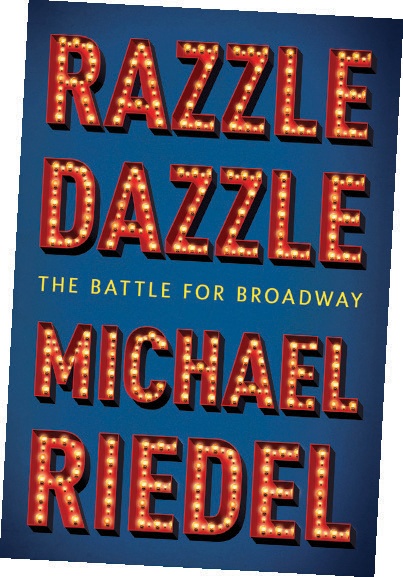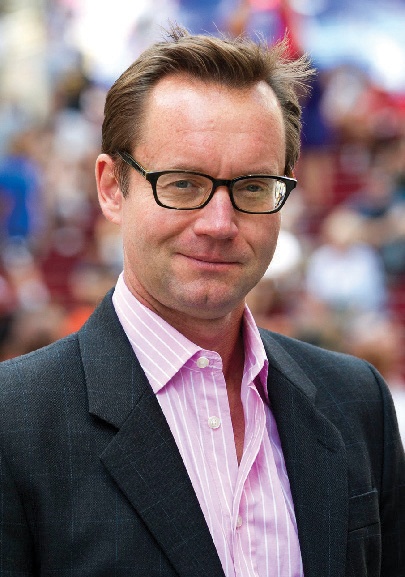Columbia College | Columbia University in the City of New York
Razzle Dazzle Raises the Curtain on Broadway's History
“New York has one thing that no other city in the world has, and that’s Broadway,” says Michael Riedel ’89, author of the gossip-rich Razzle Dazzle: The Battle for Broadway (Simon & Schuster, $27). Want to know about the hidden apartments above some of Times Square’s most desirable theaters? Or how a stuck curtain in rehearsals led to 42nd Street’s iconic opening tap number? Riedel reveals Broadway’s secrets in this behindthe-scenes history of theater and its impact on New York City.

Writer of the New York Post’s theater column since 1998, and with five years covering theater for The Daily News before that, Riedel is well positioned to take on his subject. He supplements his insider knowledge with thorough research, including interviews with some of Broadway’s biggest names — among them, The Shubert Organization chairman Philip J. Smith; cheorographer, performer and director Tommy Tune; composer Andrew Lloyd Webber; and lyricist Tim Rice.
Riedel became immersed in the theater world shortly after graduation, when he was hired as the managing editor of TheaterWeek magazine. He enlisted critic, playwright and former Columbia theater professor Eric Bentley as a contributor, and soon after took Bentley up on his offer to rent a room in his Riverside Drive apartment. Riedel says that the next two years were “like going to graduate school with the most brilliant professor you can imagine. I’d have dinner with him two or three nights per week, and we’d talk about Brecht, Shaw, Shakespeare. He had a massive library, and everything he talked about I could go read.”
That specialist knowledge is peppered throughout Razzle Dazzle. The book traces the highs and lows of NYC theater, from the Great Depression to the golden age of musicals in the ’50s and ’60s, the financial crisis in the ’70s and ’80s, and Broadway’s modern rebirth into a billion-dollar industry. It also demonstrates how deeply Broadway’s and the city’s fortunes are intertwined, beginning with the story of how the Shubert brothers (Sam, Lee and J.J.) founded their theater empire at the turn of the 20th century.
“I didn’t want to write a book that was just a little theater book,” says Riedel. “I needed a broader stage. The book works because all these shenanigans, all the gossip, the friendships and betrayals, the back-stabbing and in-fighting, the triumphs and failures — all that is taking place in front of this much larger story of New York City collapsing, and how the city revitalized itself.”

ANNE WERMIEL
Riedel gives special focus to Bernard Jacobs LAW’40 and Gerald Schoenfeld, the former heads of The Shubert Organization, and their work to revitalize the derelict Times Square area in the ’70s and ’80s. The pair, he reports, were brought into the company as attorneys for the Shubert brothers in the mid-’50s and in 1972 ousted Shubert heir Larry Shubert when his drinking and poor money management were driving the organization into bankruptcy. They then went on a mission to reinvigorate the company, moving from being just landlords of 17 Shubert-owned Times Square theaters to producing shows and seeking new works in which to invest.
The book has its share of juicy stories as well, such as how director and choreographer Michael Bennett (Dreamgirls) and his protégé Tune (Nine) feuded behind the scenes of the 1982 Tony Awards as their shows competed for the Best Musical prize. It describes how Cats went from being deemed, according to creator Webber, “a daft idea of doing a musical based on a book of poems about cats” that struggled to get funding to a global phenomenon. And it portrays producer David Merrick as a larger-than-life character, with one account detailing how he tricked investors into selling him back the rights to 42nd Street when he realized it would be a hit.
“I was blessed by the fact that it’s a book about theater people and they are, by nature, theatrical and intensely colorful, and they speak in dramatic and captivating ways,” says Riedel. “The joy of doing the book was that I got to spend a lot of time with these wonderful characters.”
Issue Contents
Published three times a year by Columbia College for alumni, students, faculty, parents and friends.
Columbia Alumni Center
622 W. 113th St., MC 4530, 6th Fl.
New York, NY 10025
212-851-7852
cct@columbia.edu
Columbia Alumni Center
622 W. 113th St., MC 4530, 4th Fl.
New York, NY 10025
212-851-7488
ccalumni@columbia.edu

